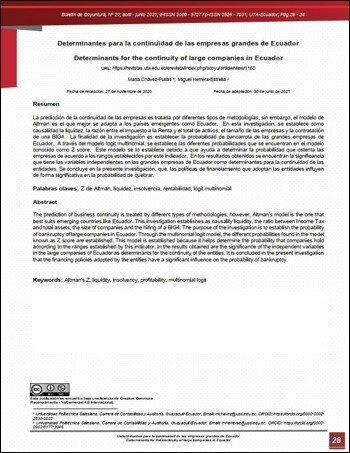Determinants for the continuity of large companies in Ecuador
Main Article Content
Abstract
The prediction of business continuity is treated by different types of methodologies, however, Altman's model is the one that best suits emerging countries like Ecuador. This investigation establishes as causality liquidity, the ratio between Income Tax and total assets, the size of companies and the hiring of a BIG4. The purpose of the investigation is to establish the probability of bankruptcy of large companies in Ecuador. Through the multinomial logit model, the different probabilities found in the model known as Z score are established. This model is established because it helps determine the probability that companies hold according to the ranges established by this indicator. In the results obtained are the significance of the independent variables in the large companies of Ecuador as determinants for the continuity of the entities. It is concluded in the present investigation that the financing policies adopted by the entities have a significant influence on the probability of bankruptcy.
URL: https://revistas.uta.edu.ec/erevista/index.php/bcoyu/article/view/1160
Downloads
Article Details

This work is licensed under a Creative Commons Attribution-NonCommercial 4.0 International License.
![]()
The publications of the Boletín de Coyuntura are licensed under a Creative Commons Attribution-NonCommercial 4.0 International License (CC BY-NC 4.0). The Universidad Técnica de Ambato retains the copyright of the published works, and favors and allows the reuse of these, as long as: the authorship and original source of publication is cited, and they are not used for commercial or onerous purposes. The intellectual property of the published articles belongs to the authors.
References
Abínzano, I., Muga, L. y Santamaría, R. (2010). ¿Es el efecto momentum exclusivo de empresas insolventes? Revista Espanola de Financiacion y Contabilidad, 39(147), 445–470.
Andrade, N., Moscoso, F. y Salcedo, C. (2017). Liquidity, profitability, tax rate and bankruptcy risk in colombian SMEs. Estudios de Administración, (1), 16–33.
Bandyopadhyay, A. (2006). Predicting probability of default of Indian corporate bonds: logistic and Z-score model approaches. Journal of Risk Finance, 7(3), 255–272. https://doi.org/10.1108/15265940610664942
Burneo, K. y Lizarzaburu, E. (2016). Gobierno Corporativo en Mercados Emergentes: Impacto en la Bolsa de Valores de Lima – BVL. Globalización, Competitividad y Gobernabilidad, 10(3), 57–115. https://doi.org/10.3232/gcg.2016.v10.n3.03
Cardona, J., Martínez, A., Velásquez, S. y López, Y. (2015). Análisis de indicadores financieros del sector manufacturero del cuero y marroquinería: un estudio sobre las empresas colombianas. Informador Técnico, 79(2), 156–168. https://doi.org/10.23850/22565035.160
Castro, D. y Pérez, A. (2017). Estimación De La Probabilidad De Incumplimiento Para Las Firmas Del Sector Económico Industrial Y Comercial En Una Entidad Financiera Colombiana Entre Los Años 2009 Y 2014. Cuadernos de Economía, 36(71), 293–319. https://doi.org/10.15446/cuad.econ.v36n71.55273.Este
Chiaramonte, L., Croci, E. y Poli, F. (2015). Should we trust the Z-score? Evidence from the European Banking Industry. Global Finance Journal, 28, 111–131. https://doi.org/10.1016/j.gfj.2015.02.002
Corbetta, P. (2013). Metodologia y Teccnicas de la investigacion Social.
Correa, J. (2005). De la partida doble al análisis financiero. Contaduria Universidad de Antioquia, (46), 169–194. Retrieved from https://search.proquest.com/docview/198764218?accountid=150292
De Llano, P., Piñero, C., & Rodríguez, M. (2016). Predicción del fracaso empresarial. Una contribución a la síntesis de una teoría mediante el análisis comparativo de distintas técnicas de predicción. Estudios de Economía, 43(2), 163–198.
Escalante, P. y Hulett, N. (2010). Importancia de la auditoría de estados financieros para las Pyme´s: Una revisión documental. Actualidad Contable Faces, 13(20), 19–28. Retrieved from http://www.redalyc.org/pdf/257/25715828003.pdf
Gómez, A. (2012). LiberaLización económica y crecimiento económico. modeLo Logit muLtinomiaL apLicado a La metodoLogía de “doing business.” Entramado, 7(1), 32–49.
Lai, D. y Chen, C. (2019). Comparison of the linear regression, multinomial logit, and ordered probability models for predicting the distribution of thermal sensation. Energy and Buildings, 188–189, 269–277. https://doi.org/10.1016/j.enbuild.2019.02.027
Le, T., Mai, V. y Nguyen, V. (2020). Determinants of profitability: evidence from construction companies listed on Vietnam Securities Market. Management Science Letters, 10, 523–530. https://doi.org/10.5267/j.msl.2019.9.028
Ochoa, Y., Toro, D., Betancur, L. y Correa, J. (2009). El indicador Z , una forma de evaluar el riesgo de continuidad. Contaduría Universidad de Antioquia, (54), 225–255.
Perez, J., Gonzáles, K. y Lopera, M. (2013). Modelos de prediccion de la fragilidad empresarial: Aplicacion al caso Colombiano para el año 2011. Red de Revistas Cientificas de America Latina, El Caribe, España y Portugal, (22), 205–228. Retrieved from http://www.redalyc.org/pdf/861/86131758010.pdf
Pérez, R., Garzón, M. y Nieto, M. (2009). Análisis empírico de la aplicación del modelo de modernización dela gestión para organizaciones en PYMES colombianas. Revista Escuela de Administración de Negocios, (65), 77–105.
Romero, F. (2013). Variables financieras determinantes del fracaso empresarial para la pequeña y mediana empresa en Colombia?: análisis bajo modelo Logit 1 Determining financial variables in the business failure to small and medium enterprises in Colombia?: analysis on Logi. Pensamiento & Gestion, 34, 235–277. https://doi.org/10.1002/0471473332
Rositas, J. (2014). Los tamanos de las muestras en encuestas de las ciencias sociales y su repercusion en la generacion del conocimiento (Sample sizes for social science surveys and impact on knowledge generation). Innovaciones de Negocios, 11(2), 235–268. Retrieved from http://www.web.facpya.uanl.mx/rev_in/Revistas/11_22/11.22 Art4 pp 235 - 268.pdf
Tascón, M. y Castaño, F. (2015). Variables y modelos para la identificación y predicción del fracaso empresarial: Revisión de la investigación empírica reciente. Revista de Contabilidad, 15(1), 7–58. https://doi.org/1138-4891
Valencia, M., Trochez, J., Vanegas, J. y Restrepo, J. (2016). Modelo para el análisis de la quiebra financiera en pymes agroindustriales antioqueñas. Apuntes Del Cenes, 35(62), 147–168. https://doi.org/10.19053/22565779.4310
Varela, R. y Nava, M. (2015). Determinantes de la búsqueda de empleo desde la ocupación: una estimación Logit Multinomial. Estudios Sociales. Revista de Alimentación Contemporánea y Desarrollo Regional, 23(45), 83–111.


